Eclectus Parrot Insights: Facts and Characteristics

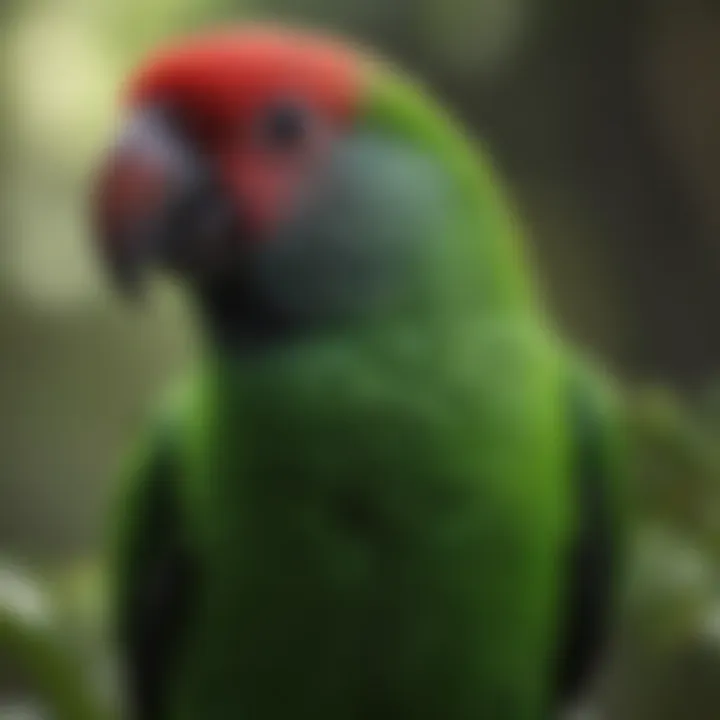
Care Tips
Taking care of an Eclectus parrot requires a commitment to their health and happiness. Daily routines play an integral role in ensuring their well-being. Typically, they need fresh fruits and vegetables, which contributes to their optimal diet. Their environment should be stimulating, backed by plenty of interaction.
Daily Care Routines
A structured daily routine helps bolsters the bond between a parrot and its owner. Start the day with feeding fresh foods and providing clean water. Spend time with your parrot, allowing it to interact outside its cage.
- Offer a variety of fresh fruits and veggies.
- Engage in playtime sessions and socialization opportunities.
- Monitor their behavior and health during interactions.
Cage Setup and Maintenance
The cage setup is vital to the overall health. A spacious cage allows freedom of movement, essential for their physical and mental stimulation. Position the cage in a well-lit area that’s free from drafts. Moreover, ensure that the bars are adequately spaced to provide security.
Maintenance Tips:
- Clean the cage thoroughly at least once a week, removing droppings and uneaten food.
- Rotate toys regularly to provide new stimulation.
- Inspect the cage for wear and tear consistently.
Hygiene and Cleaning Practices
Maintaining hygiene is crucial. This not only helps to prevent sickness but also encourages a nurturing environment. Clean all perches, dishes, and toys often. Utilize bird-safe cleaning products to avoid harmful residues.
Seasonal Care Adjustments
Different seasons may require slight adjustments to care routines. In colder months, wit needs to ensure that your Eclectus parrot stays warm. Use additional bedding for comfort. In hotter seasons, refresh water frequently to prevent overheating.
Behavioral Insights
Understanding how an Eclectus parrot communicates its feelings is beneficial for caregivers. Observing their body language is key.
Understanding Bird Body Language
Eclectus parrots convey emotions through different postures and vocalizations. For instance, a calm bird may perch upright, while an agitated one may ruffle its feathers and make loud noises.
Common Behavioral Issues and Solutions
Sometimes certain behavioral problems can occur. This may include biting or excessive screeching. Typically, these behaviors arise from boredom or stress.
Solutions Include:
- Providing more playtime.
- Ensuring your parrot is well-socialized.
Positive Reinforcement Techniques
Using positive reinforcement can enhance any training regimen. This may mean rewarding good behaviors with treats or affection.
Social Interaction Needs
Eclectus parrots thrive on interaction. They require socializing with humans or other birds to avoid becoming lonely or depressed.
Nutrition Guides
Food plays a significant role in the life of an Eclectus parrot. A well-balanced diet leads to vibrant plumage and overall health.
Essential Diet Components
A varied diet is essential. Include fruits, vegetables, pellets, and seeds as part of their meals. They tend to prefer softer foods.
Safe and Toxic Foods
It is crucial to know what is safe for your parrot to eat. Some common options are:
- Safe: Apples, carrots, leafy greens.
- Toxic: Avocado, chocolate, caffeine.
Supplements and Treats
Occasionally, dietary supplements may be beneficial. They can support nutritional needs, especially during molting or periods of stress.
Feeding Strategies for Different Species
Different types of Eclectus may require different feeding strategies. Observe specific preferences and adjust accordingly.
Wellness and Health
Regular health monitoring is essential. This ensures any health issues are caught early.
Routine Health Checkups
Schedule regular checkups with an avian vet. They can provide insight into your bird's health and offer preventative care options.
Identifying Symptoms of Illness
Being able to recognize signs of illness is vital. Look out for changes in behavior, including:
- Decreased activity levels.
- Changes in eating habits.
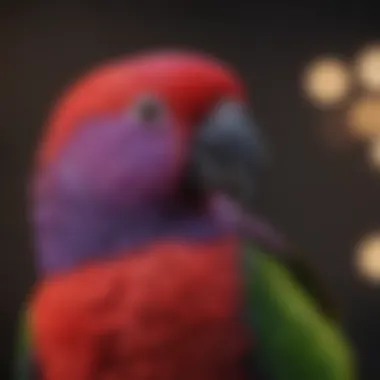
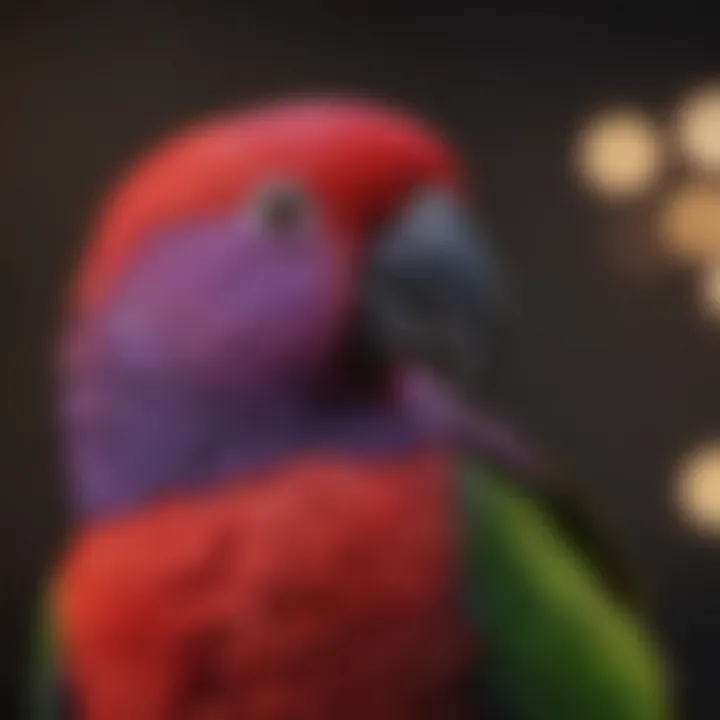
Preventative Care and Vaccinations
Preventative measures are advantageous for maintaining health. Vaccinations may be necessary based on local regulations and the vet's advice.
Mental and Emotional Well-being
Engagement is key for emotional health. Ensure that your Eclectus has daily stimulation and interaction to keep it happy.
Enriching Activities
To promote mental stimulation, various enriching activities can be provided.
Toys and Playtime Ideas
Eclectus parrots enjoy interactive toys. Rotate toys regularly to keep their environment fresh. Try introducing foraging activities to engage their instincts.
Training and Tricks
Training can be a rewarding aspect of ownership. Begin with simple commands and gradually build complexity.
Outdoor Activities and Interaction
Supervised outdoor time can provide a change of scenery. Just ensure safety measures are in place.
DIY Projects for Mental Stimulation
Creating homemade toys can also promote engagement. Use safe household items to inspire ingenuity.
It is essential to understand that an Eclectus parrot thrives in an environment enriched with care, social interaction, and mental stimulation. Human companionship plays an important role in its happiness and overall health.
Intro to Eclectus Parrots
Eclectus parrots are remarkable birds known for their striking sexual dimorphism. In essence, this means that males and females exhibit notable differences in appearance. This unique characteristic alone makes the Eclectus parrot an intriguing subject for both casual observers and serious bird enthusiasts. Recognizing these differences is essential for potential owners and breeders, as the care requirements may vary significantly between genders.
Understanding Eclectus parrots also involves exploring their natural behaviors and social structures. Within their flocks, these birds display complex interactions that can provide insight into their needs in captivity. Pet bird owners should pay attention to these social dynamics, as facilitating appropriate interaction can improve the well-being of these social creatures.
The physical appearance of Eclectus parrots often captivates new avian admirers. Males are predominantly green with hints of blue, while females showcase vivid red and purple hues. This striking contrast not only serves an aesthetic purpose but is also an integral part of their breeding process. Identifying these traits can aid in selecting a compatible pet or breeding pair.
In captivity, understanding their specific needs, such as dietary requirements and environmental preferences, is crucial. Healthy Eclectus parrots thrive when provided with a balanced diet and an enriching environment, enabling them to express their natural behaviors even when not in the wild.
Moreover, insights into their conservation status are important for responsible ownership. Awareness of ecological issues affecting these parrots can lead to informed decisions regarding breeding practices and habitat preservation efforts. Supporting conservation initiatives can ensure that future generations of these stunning birds continue to thrive in their natural habitats.
In summary, the introduction of Eclectus parrots into this article sets the stage for a comprehensive examination of their physical traits, behaviors, dietary needs, and conservation status. This knowledge will benefit pet bird owners and aspiring bird parents. The greater understanding fostered through this exploration will enhance the lives of Eclectus parrots in captivity.
Physical Characteristics
Understanding the physical characteristics of Eclectus parrots is crucial for multiple reasons. These traits not only define their physical appeal but also play a significant role in their behavior, health, and well-being. For potential parrot owners, grasping these characteristics can guide better habitat choices, dietary needs, and overall care practices. Eclectus parrots exhibit distinctive features which include size, weight, vibrant colors, and a relatively long lifespan. Detailing these attributes provides insight into what makes these birds unique and aids in fostering appropriate environments for them.
Size and Weight
Eclectus parrots typically measure between 12 to 14 inches in length, making them medium-sized birds. The weight of an adult Eclectus parrot usually ranges from 300 to 600 grams, with females generally being heavier than males. This difference is significant when preparing their living space and feeding regimen.
When choosing a cage or aviary, owners should consider the size to ensure the parrot has sufficient room to move and exercise. Understanding their size and weight can help in identifying potential health issues as well. An overweight Eclectus parrot can face numerous health risks, such as heart problems and joint issues. Thus, it is essential to monitor their diet closely as well.
Coloration and Sexual Dimorphism
One of the standout features of Eclectus parrots is their sexual dimorphism. Male Eclectus parrots showcase a striking green plumage, while females are adorned in vibrant red and purple hues. This difference is not only visually appealing but also serves a purpose in natural selection and mating behaviors. Males tend to have a more subtle coloration, which might help them camouflage in the lush foliage of their habitat.
The coloration of each sex plays a significant role in attracting mates and establishing territories. Understanding these colors can also assist pet owners in identifying behavioral shifts related to breeding or pairing. Additionally, this vivid coloration affects their dietary needs. Certain pigments found in their natural food sources contribute to maintaining this color palette, stressing the importance of proper nutrition.
Lifespan and Aging Factors
The lifespan of Eclectus parrots typically ranges from 30 to 50 years in captivity, making them a long-term commitment for any bird owner. Several factors influence their longevity, including genetics, diet, and overall care. A well-balanced diet rich in fresh fruits, vegetables, and specialized pellets contributes to their health and can prolong their life.
Aging signs can manifest as changes in plumage, behavior, or activity levels. Regular veterinary check-ups are essential for early detection of age-related health issues. By being aware of these factors, owners can implement effective care practices that ensure their Eclectus parrot thrives through its lifespan.
"The vibrant beauty and distinct characteristics of Eclectus parrots make them a fascinating choice for bird lovers. Understanding their physical traits leads to improved care and companionship."
In summary, the physical characteristics of Eclectus parrots not only contribute to their aesthetic appeal but are also vital for ensuring their health and well-being. Owners should take these factors into consideration when fostering an environment that allows their parrot to flourish.
Habitat and Distribution
Understanding the habitat and distribution of the Eclectus parrot is crucial for appreciating its unique requirements and behavior. These parrots are not just pets; they are creatures of the wild with specific adaptations that reflect their natural environments. Habitat encompasses the geographical and environmental conditions that allow the Eclectus parrot to thrive. Knowing where these birds come from can significantly influence how we care for them in captivity.
The broad geographical distribution of Eclectus parrots informs us about their natural habitats, which range across various islands in the Pacific. It is essential to recognize these distinctions, as they hold the key to ensuring a suitable living environment for these birds in captivity. Factors like climate, vegetation, and the availability of food directly affect the overall health and wellbeing of Eclectus parrots.
Natural Habitat
Eclectus parrots are native to the humid tropical rainforests of the Solomon Islands, New Guinea, and nearby regions. The typical environment consists of dense foliage that provides both shelter and food sources. They primarily inhabit lowland forests and often prefer areas near rivers and coastal mangroves. This unique habitat allows them to forage for fruits, seeds, and nuts.
In the wild, these parrots demonstrate a strong preference for having access to various perches and nest sites, which they find in the natural tangle of trees. Such environments are crucial for their behavior and social structure, both of which are affected by the complexity of their habitat. Captivity should aim to mimic such environments to promote natural behaviors.
Geographical Range
The geographical spread of Eclectus parrots is restricted to certain locales, which plays a significant role in their conservation. They are predominantly found across the islands of the Indo-Pacific region. The major populations are on the islands within the Solomon archipelago and parts of New Guinea. Although these parrots are adaptable, their existence is closely tied to specific habitats due to their ecological needs.
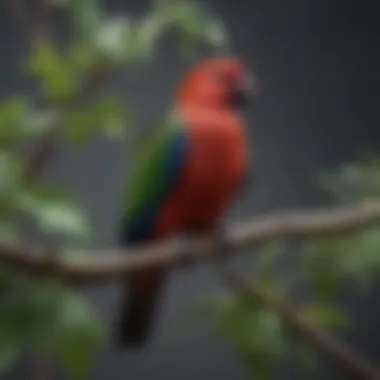
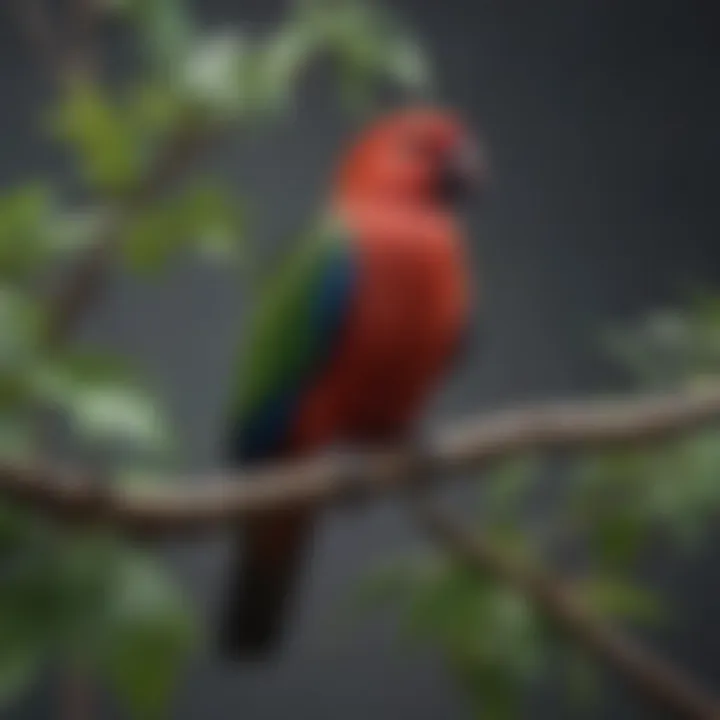
The ecological zones where they live are rich in biodiversity, providing not only food but also necessary interactions within their species. However, deforestation and habitat loss are serious threats to their wild populations, reinforcing the need for sustainable practices in aviculture.
"Conservation efforts must focus on protecting the natural habitats of Eclectus parrots to ensure their survival in the wild."
Diet and Nutrition
The diet and nutrition of the Eclectus parrot play a crucial role in its overall health and well-being. Understanding the dietary needs of this species is essential for any potential owner, handler, or enthusiast. Proper nutrition impacts their physical health, longevity, and behavior. An inadequate diet can lead to various health problems, making it imperative to be informed about their natural dietary habits and requirements.
Natural Diet in the Wild
In the wild, the Eclectus parrot has a diverse diet that primarily consists of fruits, seeds, nuts, and flowers. These parrots forage in tree canopies, selecting items that offer a mix of essential nutrients. The variety in their diet supports their high energy needs and contributes to their vibrant plumage.
Common food items include:
- Fruits like papaya, banana, and berries
- Nutritious nuts such as macadamia and almonds
- Seeds for protein and fats
- Leaves and blossoms for additional nutrients
The foraging behavior also gives them mental stimulation, which is vital in keeping them engaged. Understanding how these parrots eat in the wild helps caregivers replicate this diet as closely as possible.
Recommended Diet for Captivity
When kept as pets, Eclectus parrots require a well-rounded diet that mirrors what they would consume in their natural habitats. A mix of fresh fruits, vegetables, high-quality pellets, and occasional seeds is recommended. Some key points for feeding include:
- Base Diet: Use specially formulated pellets designed for parrots. Brands that offer bird-specific diets should provide the right balance of nutrients.
- Fruits and Vegetables: Offer a variety of colors and types. Dark, leafy greens like kale or dandelion greens are great options. Fruits can include apples, mangoes, and grapes, but must be given in moderation due to sugar content.
- Supplemental Treats: Nuts and seeds can act as training rewards but should not dominate their diet.
- Fresh Water: Change water daily to ensure it is clean and safe for consumption.
Feeding time can also be used to build trust, making it a valuable bonding experience.
Common Dietary Mistakes
Even experienced bird owners can make mistakes when it comes to feeding Eclectus parrots. Common pitfalls include:
- Overfeeding Seeds: Seeds are often high in fat and do not meet all nutritional needs. They should comprise only a small part of the diet.
- Neglecting Fresh Produce: Failing to offer enough fruits and vegetables can deprive them of essential vitamins and minerals.
- Inconsistent Diet: A sudden change in diet can upset their stomach. Gradual adjustments are necessary.
- Choosing Poor Quality Pellets: Not all pellets are created equal. Selecting those without artificial colors and fillers is important.
Attention to diet ensures a healthier, happier Eclectus parrot. Monitor their overall health and adjust their nutrition accordingly.
Behavioral Traits
Understanding the behavioral traits of Eclectus parrots is crucial for both current and prospective avian caretakers. These traits not only reflect the natural instincts of the birds but also play a significant role in their well-being and socialization within captivity. By learning about these behaviors, caretakers can create a suitable environment that meets the physiological and psychological needs of these beautiful parrots. Additionally, knowledge of their social structure and interaction patterns can lead to better bonding and communication between the birds and their human companions.
Social Structure and Interaction
Eclectus parrots are inherently social creatures. In the wild, they thrive in flocks, which provide them with a sense of security and companionship. This social structure influences their behavior in captivity. When kept alone, they may become stressed or develop behavioral issues such as feather-plucking or excessive vocalization.
It is advisable for bird owners to provide opportunities for interaction, either with other parrots or through regular engagement with humans. Building a social environment is essential; this can involve introducing a companion bird or simply dedicating quality time to interact with the Eclectus. Positive social interactions help these parrots express their natural behaviors, reducing anxiety and promoting overall health.
Communication Patterns
Communication is a vital aspect of Eclectus parrot behavior. They use various vocalizations and body language to express their feelings and needs. Each individual may develop a unique set of sounds, which can range from soft whistles to loud squawks. Understanding these communication patterns can lead to better relationships between the bird and its owner.
Vocalization serves multiple purposes, including alerting other flock members of potential threats, signaling hunger, or expressing happiness. Parrots often mimic sounds from their environment; hence, owners might notice their Eclectus imitating words or phrases. Engaging in vocal communication can enhance bonding. When owners respond to the sounds and attempts at communication, it reinforces the behavior positively.
Play and Enrichment Needs
Eclectus parrots are intelligent and require mental stimulation to thrive. Play and enrichment activities are essential to prevent boredom and encourage natural foraging behaviors. Providing a variety of toys, climbing structures, and interactive challenges is crucial.
Common enrichment strategies include:
- Rotating toys regularly to maintain interest
- Offering puzzles and foraging toys to stimulate problem-solving skills
- Setting aside time for free-flight or supervised playtime outside their cage to explore the environment
Engagement in play not only fosters curiosity but improves their physical condition. It keeps them active and ensures their mental health remains intact. Owners should observe their parrots to identify preferred activities and tailor enrichment efforts accordingly.
"Eclectus parrots are curious and social, requiring companionship and mental stimulation for their health and happiness."
Conservation Status
Understanding the conservation status of the Eclectus parrot is vital for various reasons. This section examines the current threats facing these birds in the wild, as well as the efforts to ensure their survival. It promotes awareness among pet bird owners, aspiring bird parents, and breeders about their responsibility in conserving avian species. By exploring these issues, readers can gain insights into the broader implications of avian conservation and the vital role they can play.
Threats to Wild Populations
The Eclectus parrot is not exempt from facing numerous threats that compromise its survival in the wild. Habitat loss stands as a primary threat. As urban areas expand and deforestation occurs, natural habitats of the Eclectus parrot diminish. This loss leads to a decrease in food sources and nesting sites.
Another significant threat comes from illegal trapping and trade. Despite legal protections, the Eclectus parrot is often captured for the pet trade. This not only removes individuals from their wild populations but can also disrupt the social dynamics of the species. Additionally, predation from invasive species and competition with other birds exacerbate their vulnerability.
In summary, the key threats to the Eclectus parrot include:
- Habitat Loss: Deforestation and urban development.
- Illegal Capture: Poaching for the pet trade.
- Predation and Competition: Impact of invasive species.
Conservation Efforts and Initiatives
Various initiatives aim to protect the Eclectus parrot from the threats outlined above. Conservation organizations work on multiple fronts, ranging from habitat restoration to legal reforms. One notable effort is habitat preservation programs, which focus on protecting existing forests that are crucial for the Eclectus parrot's survival.
Legal protections are also in place, but enforcement remains a challenge. Raising public awareness about the importance of conservation and the plight of the Eclectus parrot is critical. Educational campaigns can empower the local communities to participate actively in protecting their natural resources.
Additionally, captive breeding programs offer hope. These initiatives help to stabilize populations while reducing the pressure on wild birds. By providing a controlled environment, such programs aim to increase genetic diversity and ultimately reintroduce birds into their natural habitats when conditions permit.
In summary, important conservation efforts include:
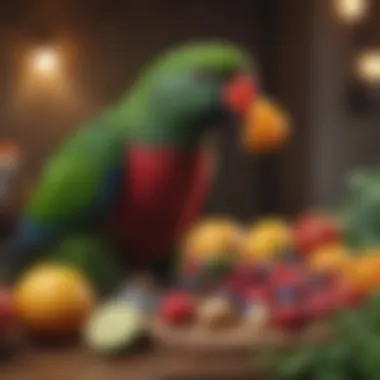
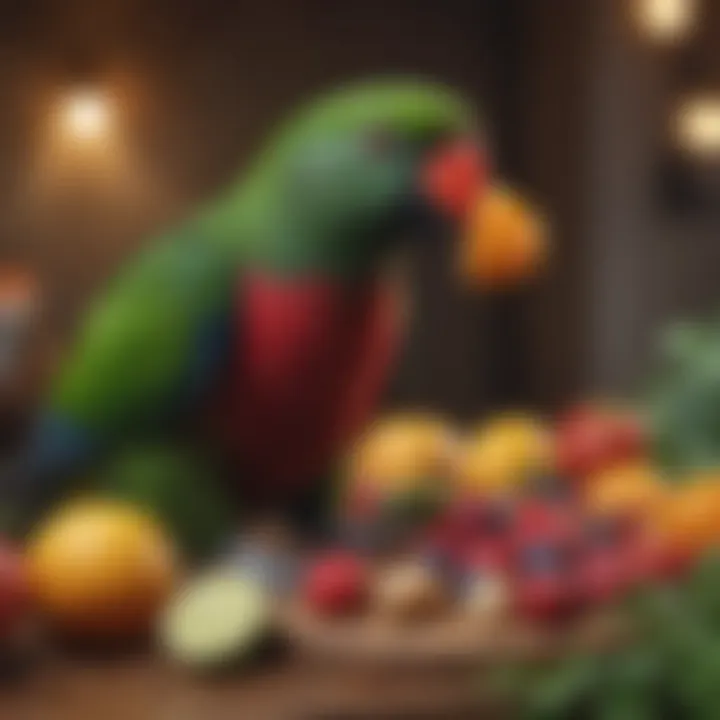
- Habitat Restoration: Protecting and restoring the natural environments.
- Legal Protections: Strengthening laws against illegal trade.
- Public Awareness Campaigns: Educating communities on conservation's importance.
- Captive Breeding: Supporting sustainable populations.
"Conservation is a shared responsibility, and every effort counts in ensuring the survival of species like the Eclectus parrot."
The conservation status of the Eclectus parrot is a critical topic, resulting in a collaborative approach to its protection. Understanding these aspects allows potential bird owners and enthusiasts to contribute more meaningfully to the wellbeing of this remarkable species.
Housing Considerations
The wellbeing of Eclectus parrots largely depends on their housing. Ensuring a proper living environment is crucial for their mental and physical health. This section will discuss cage size and structure as well as the importance of environmental enrichment.
Cage Size and Structure
When it comes to housing Eclectus parrots, cage size is a primary consideration. Ideally, the cage should be spacious enough to allow for movement and exercise. A larger cage benefits the bird by providing room to stretch its wings and engage in natural behaviors. The minimum recommended size is generally considered to be at least 24 inches wide, 24 inches deep, and 36 inches tall. However, bigger is always better. This provides ample space for toys and perches, which are essential for stimulating their curiosity and activity levels.
The structure of the cage also matters. Opting for a cage with horizontal bars encourages climbing and play, which is natural for parrots. Moreover, it is vital to have varied perch diameters, as this promotes foot health by preventing foot problems from standing on the same sized perch for too long. Seed guards can help prevent seeds and pellets from scattering, keeping the area clean. Additionally, make sure that the cage is made of non-toxic material. Metal cages are preferable, but avoid any that may rust or have harmful coatings.
Environmental Enrichment
Environmental enrichment is essential for an Eclectus parrot’s mental stimulation. Without it, parrots might exhibit stress-related behaviors such as feather plucking or excessive vocalization.
To create a stimulating environment, consider the following:
- Toys: Provide a variety of toys for chewing, climbing, and foraging. Rotate toys regularly to keep the bird interested.
- Natural Wood Perches: Using branches from non-toxic trees offers variety and mimics their natural habitat.
- Foraging: Engage their natural instincts by hiding food inside toys or placing it in different areas of the cage.
- Social Interaction: Eclectus parrots are social creatures. Daily interaction with humans or other birds is essential for their happiness and wellbeing.
"A well-structured and enriched environment keeps Eclectus parrots healthy and happy, ultimately extending their lifespan."
Maintaining a suitable housing environment ensures a positive quality of life for your Eclectus parrot. Thoughtful planning in this area pays off significantly, allowing the birds to thrive physically and mentally.
Health and Wellness
Understanding the health and wellness of Eclectus parrots is vital for any bird owner or enthusiast. A healthy parrot not only leads a more enjoyable life but also brings joy to its human companions. In this section, we will delve into common health issues these parrots may face and explore preventive healthcare practices to ensure their well-being.
Common Health Issues
Eclectus parrots, like all pets, can experience a range of health problems. Some prevalent issues include:
- Obesity: Due to their sedentary nature in captivity, these birds can become overweight. Obesity affects their overall health, leading to heart disease and liver problems.
- Feather Plucking: This behavioral issue may arise from stress, boredom, or health problems. It can lead to damaged feathers and skin infections.
- Respiratory Infections: Eclectus parrots are susceptible to respiratory diseases, often caused by poor air quality or improper housing. Symptoms include coughing, sneezing, and lethargy.
- Digestive Disorders: A poor diet can lead to gastrointestinal issues. Signs include a change in droppings, loss of appetite, or vomiting.
Familiarity with these health concerns allows owners to recognize symptoms early and seek veterinary assistance promptly.
Preventive Healthcare Practices
Preventive care is essential in maintaining the health of Eclectus parrots. Here are some key practices:
- Regular Veterinary Check-ups: Schedule annual exams with an avian vet. Routine health checks help catch potential issues before they become serious.
- Balanced Diet: Feeding a varied diet of pellets, fruits, and vegetables supports optimal health. Avoid seeds as the sole diet, as they can cause nutritional deficiencies.
- Exercise and Enrichment: Provide opportunities for physical activity and mental stimulation. Toys, social interaction, and free flight can help keep them active.
- Maintaining Clean Living Conditions: Regularly clean the cage, toys, and feeding dishes to prevent the buildup of harmful bacteria.
- Monitor Behavior and Habitat: Pay attention to any sudden changes in behavior or environment. Changes can indicate underlying health problems, requiring further investigation.
“Prevention is better than cure.” Keeping a close eye on your Eclectus parrot's health can lead to a happier, longer life.
By following these preventive practices and being aware of common health issues, caregivers can significantly enhance their Eclectus parrot's quality of life. A well-informed and proactive approach to health and wellness will ensure that these beautiful birds thrive.
Training and Bonding
Training and bonding are integral aspects of ensuring the well-being of Eclectus parrots. These parrots are intelligent, social creatures. Proper training fosters communication and trust between the bird and its owner. A well-trained Eclectus parrot not only adapts better to human interaction but also exhibits enhanced mental stimulation. Moreover, establishing strong emotional bonds leads to a healthier relationship, encouraging the bird to thrive in a home environment.
Training is not just a means to teach tricks or commands; it significantly contributes to the overall emotional state of the parrot. Building a solid bond will help the bird feel safe and secure. Given their social nature, Eclectus parrots require positive interaction to keep them mentally engaged and emotionally stable.
Effective Training Techniques
Utilizing effective training techniques is essential when working with an Eclectus parrot. Here are some recommended strategies:
- Positive Reinforcement: This method involves rewarding desired behaviors with treats or praise. Eclectus parrots respond well to positive reinforcement, making it a vital part of their training process.
- Consistency: Train at the same time daily. Create a routine that your parrot can expect. Consistency helps them understand what to anticipate during training sessions.
- Short Sessions: Keep training sessions brief, around 5 to 10 minutes. This duration engages the parrot without overwhelming it.
- Use of Clicker Training: Clicker training is effective for birds. It creates a clear connection between the behavior and the reward, leading to higher success rates in training.
Lastly, always train in a calm and distraction-free environment to enhance focus.
Building Trust and Affection
Establishing trust and affection with an Eclectus parrot is a gradual process requiring patience and care. Here are some practical tips:
- Spend Time Together: Regular interaction helps your parrot get accustomed to your presence. Quiet, gentle conversations can enhance familiarity.
- Respect Their Space: Allow your parrot to approach you on its own terms. Avoid forcing interactions, as this may cause anxiety.
- Offer Treats: Treats can be a powerful tool for building affection. Use healthy snacks to reinforce positive behaviors and close interactions.
- Observe Body Language: Understanding their body language is crucial. If they seem uncomfortable or stressed, take a step back.
Trust takes time. Show your parrot that you are a reliable and friendly figure in its life.
By implementing these strategies, owners can create a nurturing environment. This will lead to a well-adjusted, happy Eclectus parrot.
Finale
The conclusion section of this article serves as a critical synthesis of the information presented about Eclectus parrots. It highlights the substantial findings regarding their biology, habitat, behavior, and care requirements. For anyone interested in owning or understanding this unique species, grasping these multifaceted aspects is essential for responsible pet ownership and conservation efforts.
In discussing Eclectus parrots, we have explored their stunning sexual dimorphism, where males exhibit a vibrant green plumage while females showcase rich red and purple hues. This striking contrast emphasizes the importance of recognizing their unique characteristics for proper identification and care.
The comprehensive analysis of their habitat and geographical distribution informs readers about the natural environments these birds thrive in. This knowledge is crucial for pet owners to create suitable living conditions that mimic their natural settings, promoting the overall well-being of these birds.
Additionally, understanding their dietary needs and common health issues is vital for maintaining the health of Eclectus parrots in captivity. Missteps in nutrition or health care can lead to serious consequences, making it imperative for bird owners to be informed about their specific requirements.
Through the examination of different training techniques and the emphasis on building trust, the article addresses how to foster strong bonds with these intelligent creatures. Creating a positive and enriching environment allows Eclectus parrots to flourish both physically and emotionally.
Ultimately, recognizing the threats to wild populations and the ongoing conservation initiatives is critical. Supporting these initiatives ensures that future generations can appreciate the beauty and diversity of Eclectus parrots. It underlines the responsibility pet owners have not only toward their parrots but also the species as a whole.
"Knowledge is key to successful avian care and conservation."
In summary, the conclusion draws together the essential points discussed throughout this article. It is not just about keeping Eclectus parrots as pets; it is about fostering an understanding that translates into better practices for care, conservation, and overall enrichment of their lives.















